OTT full form is “Over The Top,” is a technology that lets content providers stream video and other streaming content over the internet to various devices. The OTT full form highlights its capability and it’s becoming a popular alternative to cable TV.
The OTT video sector is growing at an incredible rate, with revenues forecasted at $316.4 billion by 2024 and $429.4 billion in 2029. The United States is the top market, projected to collect $132.9 billion in revenues in 2024, demonstrating the huge potential of this technology.
The younger generation loves OTT platforms because they offer web series, TV shows, and video games.
OTT lets you watch preloaded TV episodes or any content as many times as you want. These shows and movies are usually part of a large, centralized library available in multiple languages.
If you want to learn more about what an OTT platform is, the OTT full form, and the future of entertainment, you’re in the right place.
What Is OTT Platform?
OTT platform is created by combining various streaming services that are transmitted through the internet. Its media services can be adjusted to suit any device, and content providers can reach a worldwide audience with their content. The key feature of OTT platforms is that they bypass traditional distribution channels and offer content directly to consumers.
What Does OTT Stand For?
OTT full form is “over-the-top.” This term originally referred to devices that bypassed cable operators to offer television channels directly to viewers, but it has since evolved to encompass over the top streaming services that offer a wide range of digital content.
In essence, OTT services provide a way to deliver media content directly to viewers over the internet, bypassing traditional distribution channels like cable or broadcast TV.
What is the meaning of OTT?
What is ott and OTT full form goes beyond the traditional entertainment platforms like YouTube and social media. Its goal is to elevate the entertainment experience by providing premium content accessible on computers and a range of devices. The term “premium” distinguishes it from the regular viewing experience and provides high-quality, captivating experiences for the viewers. This is made possible through wireless internet and advanced technology, ensuring exceptional visual and audio quality.
The emergence of OTT has revolutionized the entertainment industry and opened new opportunities for content creators, producers and marketers. It has opened doors to the creation of diverse, high-quality digital media content tailored to the evolving tastes and preferences of audiences.
This rapidly expanding industry offers an endless stream of entertainment to viewers across the globe.
OTT Platform vs. Traditional TV
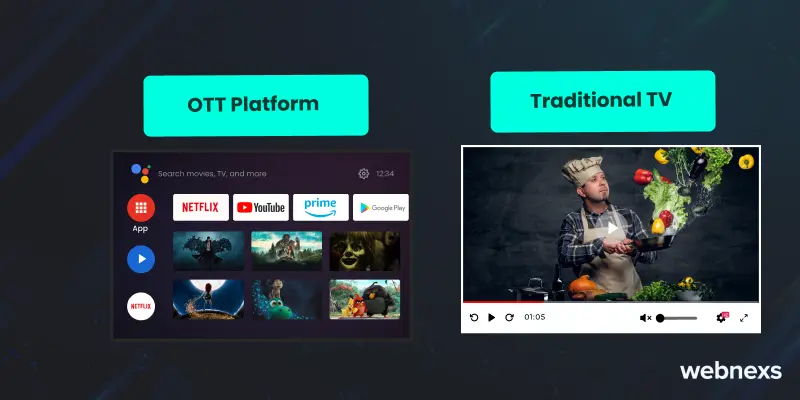
One of the biggest differences between OTT platforms and traditional TV is the way it delivered them to consumers. Traditional TV is delivered through cable, satellite, or broadcast networks, while OTT platforms deliver content over the internet. This means that users don’t need to subscribe to a cable or satellite service to access content on an OTT platform.
Another significant distinction lies in the control users have over their viewing experience. Traditional TV restricts viewers to the programming schedules determined by networks or cable providers. It offer on-demand access to a wide range of content, allowing users to watch their favorite shows and movies whenever they want. The term is also applied to online video platforms, as well as audio and video streaming solutions.
Types of OTT Platforms
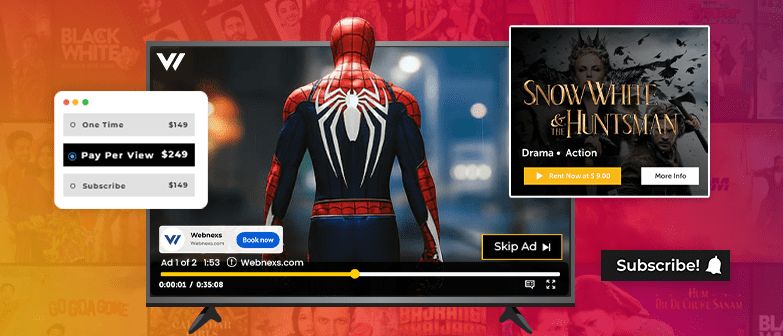
There are several different types of OTT platforms, each with its own unique features and target audience. The most prevalent types include:
Subscription Video-on-Demand (SVOD) Platforms: These SVOD platforms offer users access to a large library of content for a monthly subscription fee. Netflix, Amazon Prime Video, and Hulu are prime examples of popular streaming platforms.
Transactional Video-on-Demand (TVOD) Platforms: These TVOD platforms enable users to rent or buy individual content, such as movies or TV shows, on a pay-per-view model. Services like Amazon Instant Video and Google Play are examples.
Ad-Supported Video-on-Demand (AVOD) Platforms: These platforms offer free content to users in exchange for displaying advertisements. Examples include YouTube and Tubi.
Live Streaming Platforms: These platforms allow users to watch live streaming events, such as sports games or concerts, in real-time over the internet. Examples include ESPN+ and Sling TV.
Why Your Business Needs an OTT Solution
Unleash Your Creativity:
Meaning of OTT offers you complete control over your content, brand, user experience, audience analytics, monetization, and other archive data at the time of launch.
Moreover, you’re not bound by the same rules and regulations as on YouTube.
Ad-Free Empowerment
OTT offers consumers the ultimate freedom to choose what they want to watch and only pay for the subscription service they opt for.
Direct-to-Consumer Approach
If your viewers are curious about what is an ott full form? and what does OTT mean and how it can benefit them, you can inform them that it is the most effective way to reach your target audience with valuable content. By offering a premium VOD experience that you fully control, you can boost direct engagement and receive immediate feedback.
Freedom for Your Customers
OTT offers consumers the ultimate freedom to choose what they want to watch and only pay for the services they opt for. This level of convenience is driving industry uptake, making it more important than ever to have an OTT solution for your business.
Ready to tap into the power of an OTT platform? Look no further than Webnexs, a leading video streaming platform offering comprehensive solutions tailored to your business needs. With Webnexs, you can empower your brand with an OTT solution that puts you in control.
How to Build an OTT Platform?
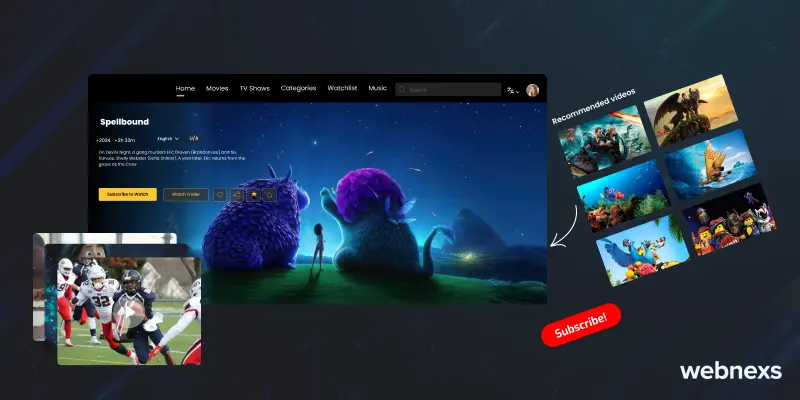
If you are looking to build an Over-the-Top (OTT) platform, there are several key factors to consider in order to make it a success. Here are some steps to help you build a prospective OTT platform:
Identify your target audience:
Determine who your target audience is and what kind of content they prefer. This will help you create a platform that caters to their needs and preferences.
Choose your niche
Identify the specific area of entertainment that you want to focus on. It could be movies, TV shows, sports, documentaries, television, or any other form of entertainment.
Content acquisition and licensing
You need to acquire the necessary licenses and rights to the content you plan to offer on your platform. You can either produce your own content or purchase licenses from existing content producers.
Develop your platform:
After defining your content and audience, the next step is to build your platform. You can either build it from scratch or use existing OTT platforms like Webnexs, Flicknexs Vimeo, Kaltura, or Brightcove.
Read More: Essential Steps for OTT Platform Beginners
Choose your monetization strategy
Determine how you plan to monetize your platform. Will you charge a subscription fee, offer ads, or use a combination of both?
Marketing and promotion
Once your platform is live, you need to promote it to attract users.Leverage social media, SEO, and paid ads to connect with your target audience.
Analyze user behavior
Utilize analytics tools to monitor user behavior and preferences. This will help you improve the user experience and offer content that resonates with your audience.
Building an OTT platform requires careful planning, a deep understanding of your audience, and a solid monetization strategy. By following these steps, you can create a VOD successful platform that delivers high-quality entertainment to your users.
Top Providers of OTT Platform Services
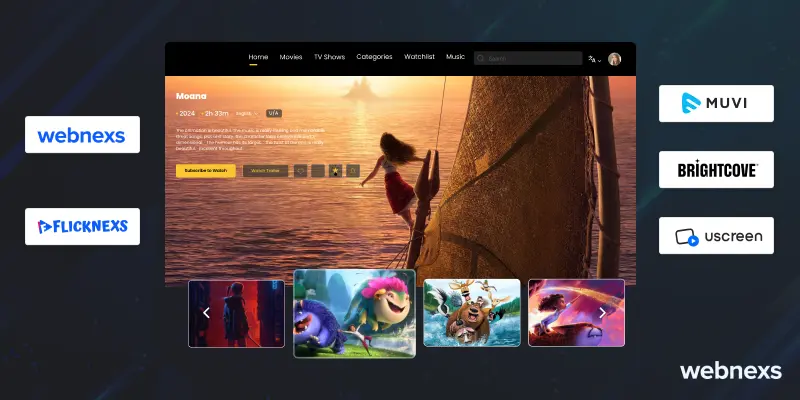
The OTT market is highly competitive, with many providers vying for consumers’ attention. Some of the top providers of OTT services include:
Webnexs
Webnexs is a comprehensive video streaming solution that allows businesses to launch their own branded OTT platform. .The platform offers a variety of features, including multi-device support, customizable templates, and integrated analytics tools.
Flicknexs
Flicknexs is another popular OTT platforms, offering a range of features, such as content management, user management, and video analytics.It also provides customizable themes and templates, making it easy for businesses to craft a unique and engaging user experience.
Brightcove
Brightcove is a leading provider of online video platforms, with a range of solutions designed for OTT (Over-The-Top) providers. The OTT full form stands for Over-The-Top.
Muvi
Muvi is a cloud-based video streaming platform that offers a range of tools and features for OTT providers. Their platform includes features such as content management, video hosting, streaming content, and monetization tools, as well as customizable themes and templates.
Uscreen
Uscreen is a video monetization platform that allows businesses to launch their own branded OTT platform (OTT full form : Over-The-Top). Key features of the platform include multi-device compatibility, custom branding options, advanced analytics tools, and various third-party service integrations.
OTT Content and Distribution
One of the main advantages of OTT platforms is the ability to offer a wider range of content than traditional TV. OTT platforms can offer niche programming that may not be available on traditional TV, as well as original programming that is exclusive to the platform. In addition, OTT platforms can offer international content that may not be available in certain regions through traditional TV channels.
OTT platforms also offer a different distribution model than traditional TV. While traditional TV relies on regional affiliates to distribute content, OTT platforms can offer content globally through the Internet. This enables a more streamlined distribution model and the potential to reach a broader audience.
OTT Platform Business Model

The business model for OTT platforms typically involves generating revenue through subscription fees, advertising, or a combination of both. SVOD platforms generate revenue through monthly subscription fees, while AVOD platforms generate revenue through advertising. Certain platforms, such as Hulu, offer both subscription and ad-supported models.
OTT platforms also have the potential to generate revenue through licensing content to other platforms or traditional TV networks. For example, Netflix has licensed some of its original programming to traditional TV networks in certain regions.
The Future of OTT Technologies
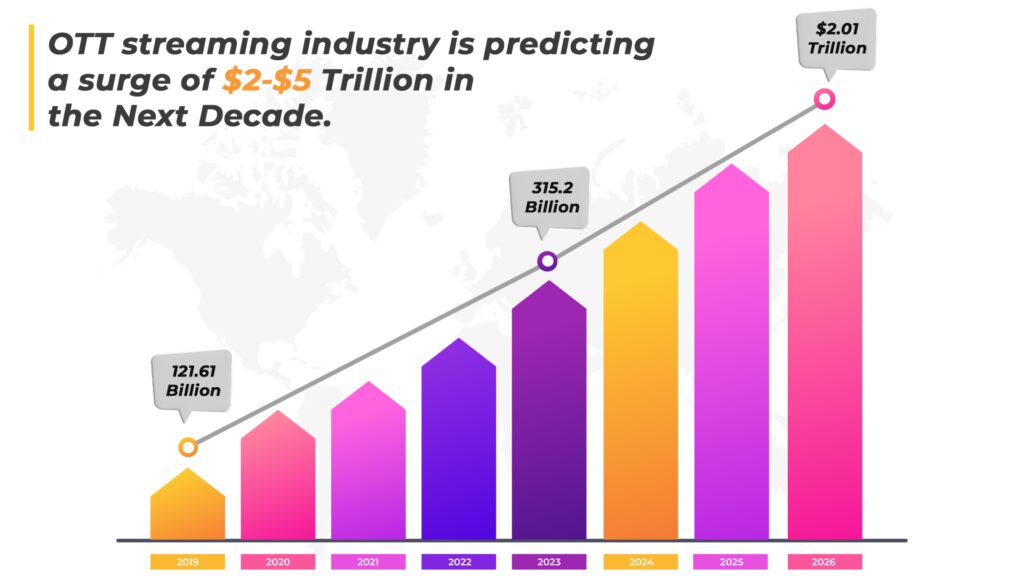
As the OTT market continues to grow, there are several key trends that are shaping the future of the industry. One trend is the increase in original programming produced by OTT platforms. Platforms such as Netflix, Amazon Prime Video, and Hulu have all invested heavily in original programming, and this trend is expected to continue as platforms look to differentiate themselves from their competitors.
Another trend is the rise of niche OTT platforms targeting specific demographics or genres. For example, Shudder is a streaming service that specializes in horror movies and TV shows, while Crunchyroll is a platform that offers anime and manga content. As the OTT market becomes more crowded, niche platforms may carve out a space for themselves by offering specialized content that isn’t available on more general platforms.
Finally, integrating OTT platforms with other devices and services is expected to continue. For example, many smart TVs now come pre-installed with OTT apps, and some cable providers are now offering their own OTT platforms besides traditional TV services. As more and more devices become connected to the internet, the potential for OTT platforms to reach new audiences will only increase.
Conclusion
OTT platforms have revolutionized the way we consume video content, offering on-demand access to a wider range of programming than traditional television. As the industry continues to evolve, we can expect to see continued innovation in terms of content production, distribution, and business models. Whether you’re a fan of classic movies, niche programming, or the latest hit TV shows, there’s an OTT platform out there for you.
OTT platforms have also allowed for more diverse voices to be heard, with independent filmmakers and content creators now able to reach a wider audience without having to go through traditional gatekeepers. This democratization of content creation and distribution is one of the most significant impacts of the OTT revolution.

